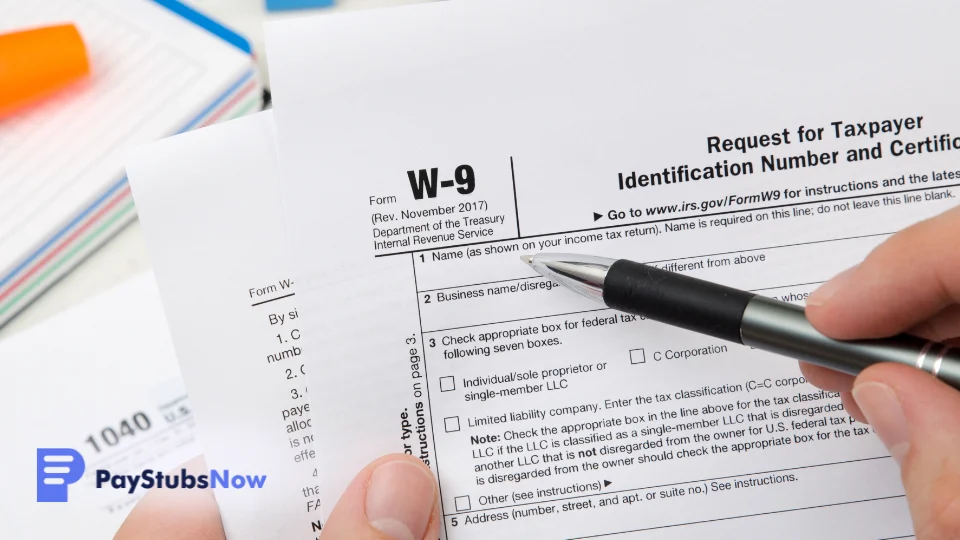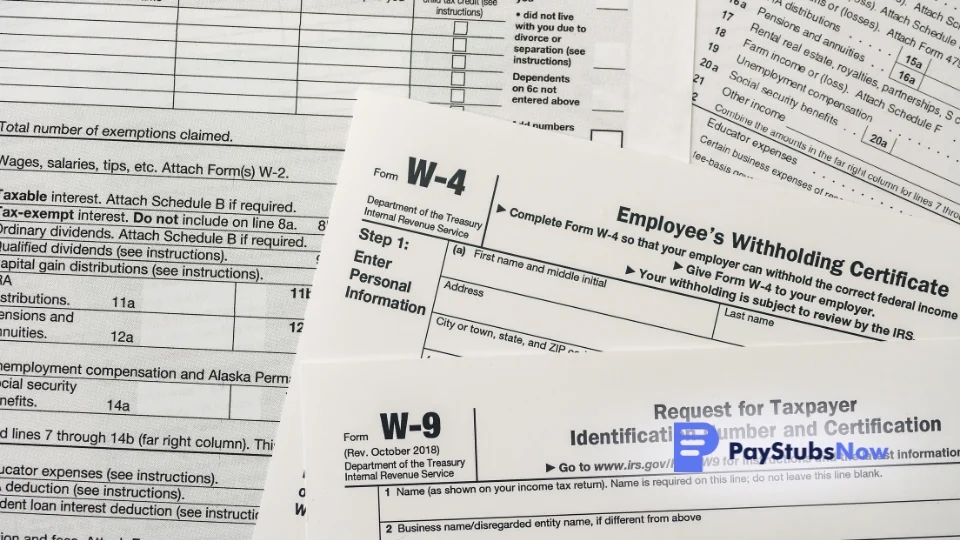What Is a W9 and How Is It Used? How To Fill out A W9 Form
You’ve finally secured that top-notch freelancer or independent contractor for your business. But amidst the thrill, there's one crucial step you can't overlook: requesting their taxpayer information through the W-9 form to file taxes.
In this blog, you'll learn why the W-9 form is important, how it's used, who needs to fill it out, and when to request it. We'll also provide a detailed, step-by-step guide to help you correctly complete the form so your freelancers can avoid mistakes that might cause issues with the IRS.
You'll also learn about how tools like Paystubsnow can make managing your financial documents easier, ensuring smooth tax compliance for your business .
Key Points of Form W-9:
- The W9 form is essential for freelancers, independent contractors, and other non-employees to provide their tax information.
- Completing the W9 accurately is crucial to avoid common mistakes that can lead to IRS issues.
- Understanding the differences between W9 and other forms like W4 can prevent confusion and ensure proper tax management.
- Using tools like Paystubsnow can streamline the process of generating and managing financial documents, enhancing tax compliance with minimal effort.
What Is the Form W9?

Form W-9, officially known as the "Request for Taxpayer Identification Number and Certification," acts as a bridge between you and the individuals you work with, such as independent contractors and freelancers. This form allows you to collect their correct Taxpayer Identification Number (TIN), which is essential for accurate tax reporting to the IRS.
The TIN can be the Social Security number (SSN) for individuals or an Employer Identification Number (EIN) for businesses.
Key Uses of the Form W9
The W-9 is used to collect the tax information for accurate reporting. Here are some key situations where you might encounter a W-9:
- Freelance Work:If you're working with a freelancer or independent contractor, you should typically request a W-9 before starting any paid engagements.
- Payments for Services:This applies to a range of situations, from receiving royalties for creative work to collecting rent from a tenant to profits.
- Investment Income:When an individual receives certain types of investment income, like dividends from real estate transactions. Even in situations like IRA contributions and mortgage interest payments exceeding a certain threshold, a W-9 might be required.
How the W9 Relates to Tax Reporting
The information independent workers/freelancers provide on the W-9 helps businesses calculate tax withholding and comply with tax reporting requirements. When companies pay these freelancers and independent contractors for their services, they're obligated to report those payments to the IRS.
Based on their W-9 information, companies issue these individuals a Form 1099 at the end of the year. This form details the total amount they were paid, which they can then report on their income tax return.
Who Requires a Completed W9 Form?
Businesses are legally required to collect W-9 forms from independent contractors and freelancers, whom they pay $600 or more in a tax year. This threshold applies to payments for services rendered, not necessarily a single payment. So, even if you receive multiple payments totaling over $600 from the same company, they'll need a W-9.
Who Must Complete Form W9?

If someone is classified as an independent contractor or freelancer, they'll likely need to complete a W-9 form whenever they start working with your company. This applies to a wide range of professions, including:
- Writers and editors
- Graphic designers and web developers
- Consultants and advisors
- Photographers and videographers
- Musicians and performers
- Handymen and home improvement contractors
When Is It Necessary to Request a W9?
As a business owner or entity making payments to independent contractors or non-employees, it's crucial to request a W-9 before issuing payments exceeding $600 a year. This ensures you have the correct tax information for filing Form 1099.
How to Fill out a W9 Step-by-Step
Filling out a W-9 is a straightforward process, but accuracy is key to avoiding delays or issues with the IRS. Here's a step-by-step guide for filling out the form correctly:
Download the Latest Form W-9 from the IRS Website
Always ask your freelancers to prioritize using the most up-to-date version of the form. They should visit the IRS website https://www.irs.gov/pub/irs-pdf/fw9.pdf and download the latest Form W-9. Using outdated forms can lead to unnecessary processing delays, so a quick download ensures everything runs smoothly.
Enter Your Legal Name and Business Name (If Applicable)
Line 1 is for the freelancer's full legal name, exactly as it appears on their tax return. If a person operates under a business name, such as a sole proprietorship or LLC they use for freelancing, enter that name on Line 2. Line 2 should be left blank if they don't have a separate business name.
Specify Your Federal Tax Classification
Line 3 asks to identify their federal tax classification by checking the appropriate box. Here's a breakdown of the choices to help them select the right one:
- Individual/Sole Proprietor:This is the most common selection for freelancers and independent contractors.
- C Corporation, S Corporation, or Partnership:Choose this option if your business operates as a corporation or partnership that files its own tax return separate from the owners.
- Limited Liability Company (LLC):This can be a bit trickier. Most single-member LLCs are considered disregarded entities for tax purposes, meaning their tax filing is treated the same as a sole proprietor. In this case, select "Individual/Sole Proprietor." However, if your LLC has multiple members or has elected to be taxed as a corporation, then you'll need to choose the appropriate corporation option.
- Other:This option is less common, but select it if none of the above categories apply to you. Again, seeking professional guidance is recommended in this case.
Provide Your Taxpayer Identification Number (SSN or EIN)

This crucial information goes on Line 5. Here's what to enter:
- Social Security Number (SSN):This is the most common option for independent contractors and freelancers filing taxes as individuals.
- Employer Identification Number (EIN):If you operate a business as a corporation, partnership, or LLC, you likely have an EIN. Use this number on the W-9.
Fill in Your Address and Contact Details
Lines 6 through 8 require your complete mailing address. This should be the address where you want to receive any important tax documents or correspondence related to the payments you'll be receiving. Here's what to include:
- Line 6:Enter your street address, including any apartment or suite number.
- Line 7:Fill in your city, state, and zip code.
- Optional: Line 8While not mandatory, you can include your daytime phone number or email address on this line for easier communication with the payer.
Make sure the address you provide on the W-9 matches the address you use on your tax return . This consistency helps prevent any mismatches that could delay processing or lead to errors.
Review and Certify the Information by Signing the Form
The bottom portion of the W-9 form requires the employee's signature and date to validate the information they provided. Here's what each line signifies:
- Line 1 (Signature):Sign your legal name exactly as it appears on Line 1 of the form. This ensures consistency and avoids any confusion during processing.
- Line 2 (Date):Fill in the current date using the format "MM-DD-YYYY" (e.g., 05-17-2024).
By signing the W-9, the employee certifies that all the information they provided on the form is true, accurate, and complete. This signature holds legal weight, so they must ensure everything is correct before signing.
Double-Check All Entries for Accuracy and Completeness
Take a moment to carefully review all the information you've filled in. Ensure there are no typos or errors, especially in your Social Security Number or EIN. Mistakes can lead to processing delays and potential tax complications.
Submit the Completed Form to the Requester and Keep a Copy for Your Records
Once you've reviewed and signed the form, submit it to the company or individual who requested it. They might require you to mail it, upload it electronically, or provide a signed copy in person. Regardless of the method, keep a copy of the completed W-9 for your tax records.
W9 vs. W4: Understanding the Differences

At this point, you're well-equipped to handle a W-9 form with confidence. But you might wonder about another form with a similar-sounding title: the W-4. Let's clear up any confusion and understand the key differences between these two tax forms:
- W-9 (Request for Taxpayer Identification Number and Certification):This IRS form gathers your tax identification information (SSN or EIN) for accurate reporting of payments made to you as an independent contractor or freelancer. Independent contractors and freelancers complete a W-9 form and submit it to their companies. Since you're considered self-employed with a W-9, you're responsible for paying your own income taxes.
- W-4 (Employee's Withholding Allowance Certificate):Employers use this form to calculate the tax withholding from employees' paychecks. Employees fill out a W-4 and submit it to their employer. With a W-4, an employer withholds income tax from an employee's paycheck based on the information they provide. The employee will still need to file a tax return, but any federal income tax withheld will be applied toward their tax liability.
In a nutshell, W-9 forms are used for independent contractors, while W-4 forms are for organizational employees .
Make Form Management Easier With Paystubsnow
Understanding the purpose and proper completion of a W9 form is crucial for both independent contractors and the businesses that hire them.
As you navigate these essential tax forms, Paystubsnow is here to support you. Not only do we provide detailed guidance on filling out W9 forms, but we also offer a comprehensive suite of payroll form generators.
Our platform ensures the accurate creation of vital documents such as paystubs, invoices, W2s, and 1099 forms, simplifying your payroll processes.
Stay compliant and streamline your operations with Paystubsnow’s user-friendly tools. Generate paystubs now with Paystubsnow and make managing your payroll easier than ever!
Remember: Even though professionals use and trust Paystubsnow, we are not a CPA (Certified Public Accountant) firm, law firm, or legal advisory service. Our website helps you easily create paystubs, invoices, W2s, and 1099 forms. We don't provide legal or tax advice. It's always a smart idea to consult with your own CPA, tax advisor, or lawyer to ensure you're complying with all applicable laws and regulations.

